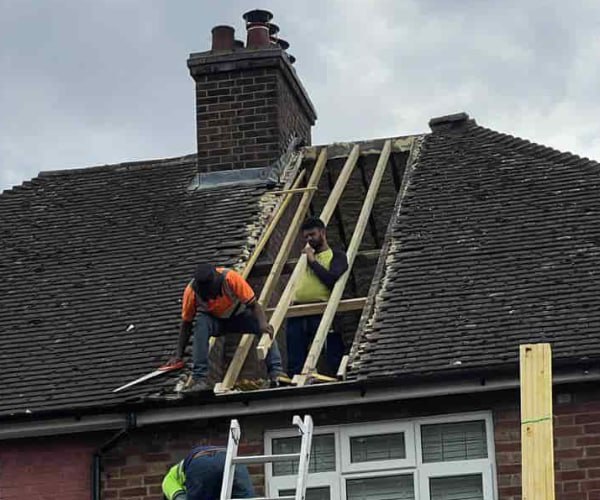Why Your Felt Roof Needs More Attention After Heavy Rains
Felt roofing has long been a reliable and cost-effective option for flat roofs, garages, extensions, and sheds. However, like any roofing material, it requires regular maintenance to ensure it remains in good condition, especially after heavy rain. In areas like Wollaston, Northamptonshire, where the weather can be unpredictable, it’s crucial to give your felt roof the attention it needs after storms or prolonged rainfall. At BMT Roofing Wollaston, we understand the unique challenges felt roofs face in the UK climate and why post-rain inspections are so essential.
How Heavy Rain Impacts Felt Roofing
Felt roofing is designed to be waterproof, but heavy and persistent rainfall can place a strain on any roof. Over time, even the best-installed felt roof can develop issues due to prolonged exposure to water. Here are the main ways heavy rain can affect felt roofs:
1. Pooling Water
Felt roofs are commonly used on flat or low-pitched surfaces, which can lead to water pooling after a heavy downpour. When water doesn’t drain properly, it can sit on the surface, increasing the risk of leaks or weakening the roof material over time. Persistent pooling can cause the felt to degrade faster, leading to cracks, bubbles, and tears in the roofing membrane.
2. Water Seepage Through Worn Felt
Over time, felt roofs can develop wear and tear from exposure to the elements. Small cracks or seams can open up, allowing water to seep through during heavy rains. This can lead to damage not only to the roof itself but also to the underlying structure. Water ingress can result in damp patches, ceiling stains, and even mould growth within your property.
3. Blocked Drainage Systems
During heavy rain, debris such as leaves, branches, or dirt can clog gutters and downpipes, preventing water from draining off the roof effectively. A blocked drainage system can cause water to back up onto the roof, leading to pooling and eventual leaks. This is particularly problematic for felt roofs, which are more vulnerable to water damage when drainage is compromised.
Why Post-Rain Inspections Are Essential
After a period of heavy rain, it’s important to inspect your felt roof to ensure it hasn’t sustained any damage. Identifying and addressing issues early can prevent costly repairs and extend the lifespan of your roof. Here’s why post-rain inspections are crucial:
1. Spotting Damage Early
Water damage can start small but quickly worsen if left unchecked. After heavy rain, it’s essential to look for signs of water pooling, cracks, or wear in the felt. By addressing these issues early, you can prevent further damage that might compromise the structural integrity of your roof.
2. Preventing Leaks and Water Ingress
One of the biggest risks after heavy rain is water getting into your property through the roof. Even a small gap in the felt can allow water to seep through, leading to leaks and potential damage to your ceilings, walls, and belongings. Regular inspections help to identify these vulnerabilities and prevent leaks before they cause major problems.
3. Extending the Roof’s Lifespan
A well-maintained felt roof can last up to 20 years, but neglecting regular maintenance and inspections, especially after heavy rainfall, can significantly reduce its lifespan. Taking care of minor repairs and ensuring proper drainage helps to protect your roof and ensure it lasts as long as possible.
What to Look for After Heavy Rain
After a bout of heavy rain, there are several key things to check on your felt roof:
- Pooling Water: Look for any areas where water isn’t draining properly. Pooling water can accelerate the breakdown of felt and lead to leaks.
- Cracks or Tears: Inspect the surface of the felt for any signs of damage, such as cracks, bubbles, or tears in the material. These can allow water to penetrate and cause further damage.
- Seam Integrity: Check the seams where the felt is joined. If the seams have come apart or are loose, water can easily seep in.
- Gutters and Downpipes: Ensure that your gutters and downpipes are clear of debris and that water is flowing freely. Blockages can cause water to back up onto the roof, leading to potential damage.
Professional Roof Maintenance Services
While it’s a good idea to inspect your felt roof yourself after heavy rain, hiring a professional roofing service is the best way to ensure a thorough assessment. At BMT Roofing Wollaston, we offer comprehensive post-rain inspections and felt roof maintenance services to keep your roof in excellent condition.
Our team of experienced roofers can identify potential issues that may not be immediately visible, such as weakened felt or hidden leaks. We’ll provide expert advice on whether repairs are needed or if preventative maintenance can help extend the life of your roof.
Conclusion
Heavy rain can put your felt roof under significant stress, increasing the risk of water damage, leaks, and premature wear. Regular post-rain inspections and prompt repairs are essential to maintaining the integrity of your roof and preventing costly damage to your home. At BMT Roofing Wollaston, we’re committed to providing professional roofing services that ensure your felt roof remains in top condition, no matter the weather..
Call us on: 01933 823 289
Click here to find out more about BMT Roofing Wollaston
Click here to complete our contact form and see how we can help with your roofing needs.

